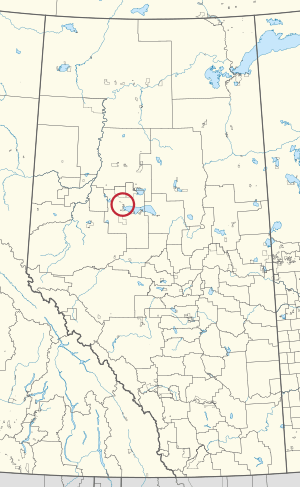Kapawe'no 150B facts for kids
Quick facts for kids
Kapawe'no 150B
formerly Freeman 150B
|
|
|---|---|
| Kapawe'no Indian Reserve No. 150B | |

Location in Alberta
|
|
| First Nation | Kapawe'no |
| Treaty | 8 |
| Country | Canada |
| Province | Alberta |
| Municipal district | Big Lakes |
| Area | |
| • Total | 29.6 ha (73.1 acre) |
| Population
(2016)
|
|
| • Total | 154 |
Kapawe'no 150B, once known as Freeman 150B, is a special area of land called an Indian reserve. It belongs to the Kapawe'no First Nation people. This reserve is located in the province of Alberta, Canada. It is part of Big Lakes County and sits about 8 kilometers (5 miles) northwest of Lesser Slave Lake. In 2016, about 154 people lived here in 45 homes.
Contents
What is Kapawe'no 150B?
Kapawe'no 150B is a small but important piece of land. It is set aside for the Kapawe'no First Nation. This land helps the community keep their culture and traditions alive. It also provides a place for their members to live and gather.
Location and Size
This reserve is found in a beautiful part of Alberta. It is close to Lesser Slave Lake, which is one of the largest lakes in the province. The reserve covers an area of 29.6 hectares. That's about the size of 55 football fields!
The Kapawe'no First Nation
The Kapawe'no First Nation is one of many Indigenous groups in Canada. They are part of the larger Cree nation. First Nations are the original inhabitants of this land. They have rich histories, languages, and ways of life. The Kapawe'no people have lived in this area for a very long time.
Treaty 8 and Its Meaning
Kapawe'no First Nation is a signatory to Treaty 8. A treaty is like a big agreement between First Nations and the Canadian government. Treaty 8 was signed in 1899. It covers a huge area of land in northern Alberta, British Columbia, Saskatchewan, and the Northwest Territories. These treaties were meant to share the land and resources. They also recognized the rights of Indigenous peoples.
Life on the Reserve
Life on Kapawe'no 150B is centered around community and culture. The people work to preserve their heritage. They pass down their knowledge to younger generations. Many activities focus on traditional practices.
Community and Population
In 2016, 154 people called Kapawe'no 150B home. This number can change over time. The community works together to support each other. They aim to create a strong and healthy environment for everyone.
Local Environment
The area around Kapawe'no 150B is rich in nature. Being close to Lesser Slave Lake means there are many opportunities for outdoor activities. These might include fishing, hunting, and connecting with the land. The natural environment is very important to the Kapawe'no people.

